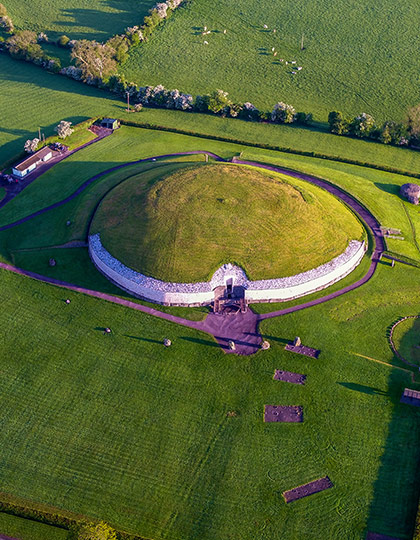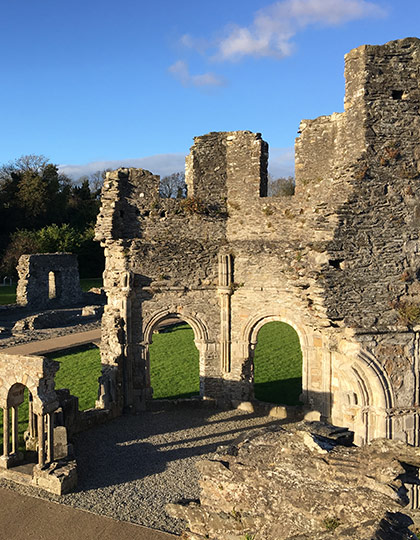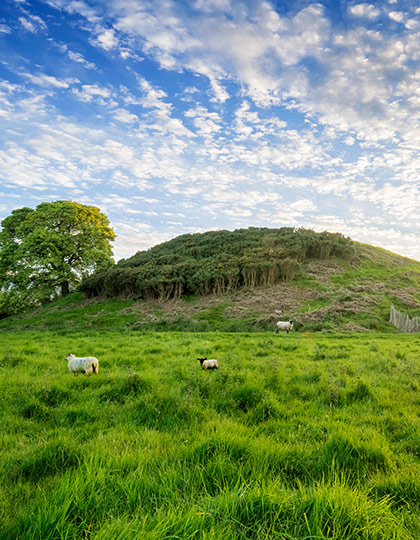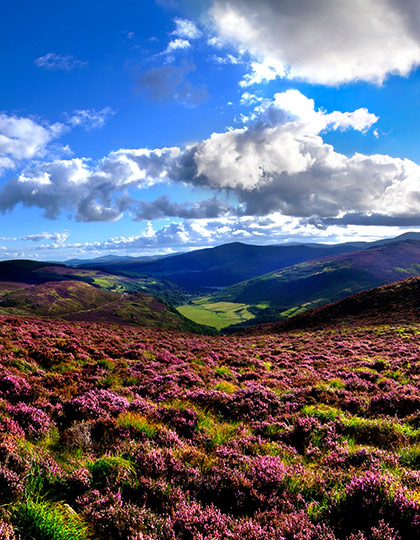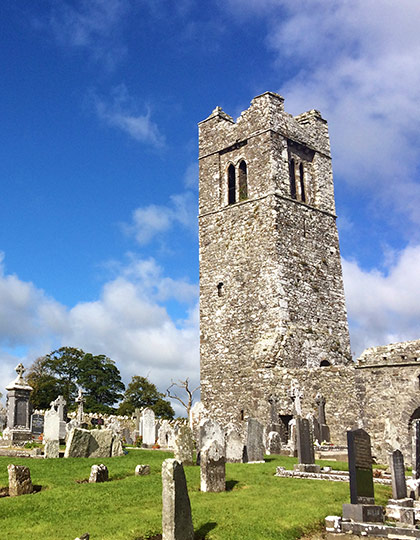This website uses cookies to help deliver its services. By using this website, you agree to the use of cookies as outlined in our Privacy Policy.
Ireland’s Ancient East Books
 Ireland’s Ancient East: A Guide to Its Historic Treasures by Neil Jackman showcases one hundred sites across Ireland’s Ancient East, from Carlingford in County Louth, through the Boyne Valley of County Meath, into the heartlands of Tipperary and Kilkenny before ending up in Cork.
Ireland’s Ancient East: A Guide to Its Historic Treasures by Neil Jackman showcases one hundred sites across Ireland’s Ancient East, from Carlingford in County Louth, through the Boyne Valley of County Meath, into the heartlands of Tipperary and Kilkenny before ending up in Cork.
Visit sites such as Clonmacnoise, Newgrange and the Rock of Cashel, as well as a large number of hidden gems like Athassel Priory in Tipperary, Gaulstown Dolmen in Waterford and Loughcrew Passage Tombs in Meath.
Take an immersive journey of discovery through over 5,000 years of Ireland’s history, heritage, archaeology and folklore. Includes practical information about how to find the sites and what to expect from the visitor experience. Lavishly illustrated and with easy-to-follow maps, this is the first guide to this brand new venture.
Purchase at Amazon.com or Amazon.co.uk
Boyne Valley Sites included in Ireland’s Ancient East: A Guide to Its Historic Treasures : Mellifont Abbey, Monasterboice, Loughcrew, Bective Abbey, Hill of Tara, Hill of Slane, Newgrange, Knowth and Fourknocks.
Newgrange
Newgrange is a 5,000-year-old passage tomb located in County Meath, Ireland, and is a remarkable testament to the Neolithic civilization’s architectural and astronomical achievements. This ancient monument, consists of a massive circular mound with a long, narrow passage leading into its heart. What makes Newgrange truly extraordinary is its alignment with the winter solstice; during the days surrounding the solstice, sunlight penetrates the passage and illuminates the central chamber, creating a breathtaking spectacle of ancient solar engineering.
Newgrange
 Newgrange is the most visited archaeological site in Ireland. Every year around 250,000 people come to the see this Neolithic passage tomb. Designed for the general reader with an interest in Irish prehistory, this book explains the results of decades of excavation and analysis in one volume. It is written in a lively style that seeks at the same time to be authoritative and thorough.
Newgrange is the most visited archaeological site in Ireland. Every year around 250,000 people come to the see this Neolithic passage tomb. Designed for the general reader with an interest in Irish prehistory, this book explains the results of decades of excavation and analysis in one volume. It is written in a lively style that seeks at the same time to be authoritative and thorough.
Aside from its accessibility and good state of preservation, Newgrange’s Winter solstice phenomenon, in particular, has made it famous throughout the world. While it is the best-known ancient site in Ireland, many aspects of Newgrange are not clearly understood; other aspects are just taken for granted: why is there a three meter high quartz wall around its entrance; how does the roof box work; what was the inspiration for its art and architecture?
The book is arranged in such a way as to replicate a visit to the site. It pauses over points of art and construction that the visitor will not have had time to examine in detail on a conventional guided tour. Newgrange is the synthesis of years of excavation and research at home and abroad; from the detailed reports stemming from the excavations of M.J. O’Kelly to the current international debate about its construction and reconstruction.
This is the first book on Newgrange to draw on O’Kelly’s private papers and to incorporate the results of more recent and as yet unpublished excavations. This book will clarify many complex issues that have been addressed in widely scattered publications, using original illustrations to assist the reader, and more importantly, it places the monument in its broader cultural context. Purchase at Amazon.com or Amazon.co.uk
Newgrange and the Boyne Valley
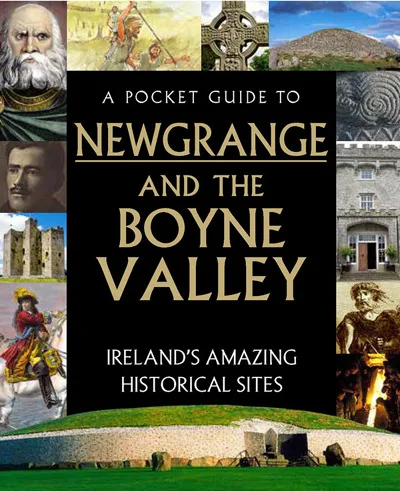 A Pocket Guide to Newgrange and the Boyne Valley. Older than Stonehenge, older than the Pyramids, Newgrange in Co. Meath was built over 5,000 years ago. This remarkable Neolithic structure by the legendary River Boyne has fascinated visitors for millennia, but became a significant tourist site after its excavation and partial reconstruction by archaeologist Michael O’Kelly in the 1960s and 70s. Regarded as Ireland’s greatest national monument, Newgrange has entered Irish mythology through its associations with ancient deities, and today it continues to fascinate archaeologists and visitors alike.
A Pocket Guide to Newgrange and the Boyne Valley. Older than Stonehenge, older than the Pyramids, Newgrange in Co. Meath was built over 5,000 years ago. This remarkable Neolithic structure by the legendary River Boyne has fascinated visitors for millennia, but became a significant tourist site after its excavation and partial reconstruction by archaeologist Michael O’Kelly in the 1960s and 70s. Regarded as Ireland’s greatest national monument, Newgrange has entered Irish mythology through its associations with ancient deities, and today it continues to fascinate archaeologists and visitors alike.
A Pocket Guide to Newgrange and the Boyne Valley contains everything you need to know about one of Ireland’s most significant historical landmarks.
Purchase at Amazon.com or Amazon.co.uk
Exploring Newgrange
 Exploring Newgrange: Exploring the Majestic Passage Tombs of Ancient Ireland By Liam Mac Uistin. Older than the Egyptian pyramids, older than Stonehenge, for 5,000 years the ancient megalithic tomb at Newgrange in County Meath has housed the remains of Stone Age aristocracy , sheltering the spirits of the long dead from the outside world. This book explores the creation, building and discovery of Newgrange.
Exploring Newgrange: Exploring the Majestic Passage Tombs of Ancient Ireland By Liam Mac Uistin. Older than the Egyptian pyramids, older than Stonehenge, for 5,000 years the ancient megalithic tomb at Newgrange in County Meath has housed the remains of Stone Age aristocracy , sheltering the spirits of the long dead from the outside world. This book explores the creation, building and discovery of Newgrange.
Why did these people spend years building this tomb? How did they move huge boulders miles across hilly country and erect them at the site, without the aid of machinery? Modern archaeological techniques have revealed much about the lives of our Stone Age ancestors, but Newgrange still retains many of its secrets. Exploring Newgrange uncovers, in words and illustrations, the extent, and limitations, of our knowledge of this world-famous site.
Purchase at Amazon.com or Amazon.co.uk
Exploring Newgrange by Liam Mac Uistin is an excellent introduction to Newgrange and the other Brú na Bóinne Megalithic Passage Tombs at Knowth and Dowth. This very readable book includes maps, reconstruction drawings and photographs. With 111 pages this book is certainly not an in-depth academic study of the wonderful and mysterious Boyne Valley Monuments. While the sleeve notes describe Newgrange as “an amazing stone age place of mystery and spiritual worship”, the books itself is written in an encyclopedic type style which will suit readers who are just beginning to learn about Newgrange.
Newgrange and the Bend of the Boyne
 Newgrange and the Bend of the Boyne by Geraldine Stout is a wonderful 236 page historical geography of the Boyne Valley covering 7000 years, from prehistory to the twentieth century. The megalithic mounds at Newgrange, Knowth and Dowth are extensively covered.
Newgrange and the Bend of the Boyne by Geraldine Stout is a wonderful 236 page historical geography of the Boyne Valley covering 7000 years, from prehistory to the twentieth century. The megalithic mounds at Newgrange, Knowth and Dowth are extensively covered.
Newgrange and the Bend of the Boyne is the exploration of an outstanding archaeological landscape centered on Newgrange Passage Tomb and its greater environs. In ancient times it was called the Brugh na Boinne. Today this area is designated as a World Heritage site and is Ireland’s first protected Archaeological Park. Its rich fertile soils and south-facing slopes are set in County Meath in the most accessible, low-lying part of Ireland, close to the Irish Sea.
This is where the great pre-historic tomb-building tradition of Atlantic Europe reached its zenith. It is where legend says the foundations of Irish Christianity were laid and is also the home of Ireland’s first medieval Cistercian monastery at Mellifont. On the banks of the Boyne in 1690 one of the most important battles in Irish history was fought.
Purchase at Amazon.com or Amazon.co.uk
Newgrange: Archaeology, Art and Legend
 Newgrange: Archaeology, Art and Legend (New Aspects of Antiquity).
Newgrange: Archaeology, Art and Legend (New Aspects of Antiquity).
Professor O’Kelly, the most distinguished authority on Newgrange, demonstrates that this remarkable megalithic tomb, ‘the great national monument of Ireland, was built about 3200 BC by Neolithic farmers, who possessed considerable expertise in engineering, architecture, art and astronomy.’
Not only did they erect a monument which has stood virtually intact for thousands of years, but they deliberately orientated it so that each year, on midwinter’s day, the rays of the rising sun would shine through a special aperture to illuminate the inner passage and chamber.
Every stage in the excavation, interpretation and restoration of the site is described and fully illustrated, with additional major contributions from Claire O’Kelly, who collaborated in her husband’s work at Newgrange from its beginning.
Purchase at Amazon.com or Amazon.co.uk
Guide to the Passage Tombs at Brú na Bóinne
 Guide to the Passage Tombs at Brú na Bóinne. This 32 page concise guide by George Eogan and Peigin Doyle presents what we know about the builders of Brú na Bóinne – who they were, how they lived, and what compelled them to create their mighty monuments. This is also the story of the tombs themselves, how they were built, and how their use and the ceremonial activity centered on them evolved over time.
Guide to the Passage Tombs at Brú na Bóinne. This 32 page concise guide by George Eogan and Peigin Doyle presents what we know about the builders of Brú na Bóinne – who they were, how they lived, and what compelled them to create their mighty monuments. This is also the story of the tombs themselves, how they were built, and how their use and the ceremonial activity centered on them evolved over time.
Purchase at Amazon.com or Amazon.co.uk
Newgrange – Monument to Immortality
 Newgrange – Monument to Immortality by Anthony Murphy looks beyond the archaeology and the astronomy to reveal a much more profound and sacred vision of the very spirit of the people who built Newgrange. Many people who visit the ancient and magnificent Newgrange monument in the Boyne Valley are driven by some deep longing to connect with their most distant roots. The giant 5,000-year-old megalithic construction evokes awe and wonderment, and a keen sense of melancholy for the community of people who created and fashioned it from stone and earth in the remote past, a people now lost to time.
Newgrange – Monument to Immortality by Anthony Murphy looks beyond the archaeology and the astronomy to reveal a much more profound and sacred vision of the very spirit of the people who built Newgrange. Many people who visit the ancient and magnificent Newgrange monument in the Boyne Valley are driven by some deep longing to connect with their most distant roots. The giant 5,000-year-old megalithic construction evokes awe and wonderment, and a keen sense of melancholy for the community of people who created and fashioned it from stone and earth in the remote past, a people now lost to time.
For the past three centuries, archaeologists, antiquarians, writers and researchers have been probing Newgrange in the hope of revealing something about its purpose, and something about the mysterious people of the New Stone Age who created giant structures using primitive technology. What has become clear from these investigations is that Newgrange is a uniquely special place, and that its construction was carried out not by a grizzly mob of grunting barbarians, but rather by an advanced agrarian community who had developed keen skills in the sciences of astronomy, engineering and architecture.
The writer and researcher Anthony Murphy goes deep into the mind and soul of his Neolithic ancestors to attempt to draw forth some answers to these questions. In a deeply moving, poetic and philosophical exploration, he looks beyond the archaeology and the astronomy to reveal a much more profound and sacred vision of the very spirit of the people who were driven to such wondrous efforts. Purchase at Amazon.com or Amazon.co.uk
Knowth
Knowth is the largest of the passage tombs within the Brú na Bóinne complex, situated in the Bend of the Boyne. Built around 3200 BCE the main mound is encircled by 18 smaller satellite mounds. The main mound was surrounded by 127 kerbstones of which 124 remain. Within the main mound there are two passages, one facing east and the other west. Knowth’s eastern passage claims the title of the lengthiest among Irish passage tombs, measuring an impressive 130 feet (40 meters) and holding the record for the longest in western Europe. A remarkable showcase of megalithic art, Knowth boasts more decorated stones than any other Neolithic monument in western Europe, with 90 of its 124 kerbstones featuring stone age designs.
The Megalithic Art of the Passage Tombs at Knowth
 Excavations at Knowth Volume 7: The Megalithic Art of the Passage Tombs at Knowth, Co. Meath. The complex of passage tombs at Knowth is dated circa 3200-2900 BC, and this volume deals with one of the most significant aspects of the site. It presents a complete catalogue of the 390 recorded carved stones at Knowth, through descriptions, drawings and photographs.
Excavations at Knowth Volume 7: The Megalithic Art of the Passage Tombs at Knowth, Co. Meath. The complex of passage tombs at Knowth is dated circa 3200-2900 BC, and this volume deals with one of the most significant aspects of the site. It presents a complete catalogue of the 390 recorded carved stones at Knowth, through descriptions, drawings and photographs.
Six main styles of art have been identified and these are discussed, together with the motifs and techniques employed. The Knowth carvings constitute circa 46% of all such art in Ireland, and the volume sets the Knowth art in the context of the other Irish carvings, those in western and northern Britain, and also the somewhat earlier art found on megalithic tombs in Atlantic Europe.
Book review by Dr Stephen Davis (UCD), Irish Arts Review, Spring 2022 – This substantial volume represents a fitting coda to almost sixty years of research led by Professor George Eogan and the culmination of over five decades of research on megalithic art by Dr Elizabeth Shee Twohig. There is plenty here for both the specialist and the amateur alike. This is an absolutely essential book for anyone with an interest in megalithic art and the European Neolithic, and comes highly recommended.
Purchase at Amazon.com or Amazon.co.uk
The Passage Tomb Archaeology of the Great Mound at Knowth
 Excavations at Knowth Volume 6: The Passage Tomb Archaeology of the Great Mound at Knowth. The ancient burial sites of Knowth, Newgrange and Dowth make up the archaeological complex at Brugh na Bóinne, a UNESCO world heritage site which has attracted enormous international interest. George Eogan began excavating the site at Knowth in 1962 and this is the sixth volume of the Excavations at Knowth monograph series.
Excavations at Knowth Volume 6: The Passage Tomb Archaeology of the Great Mound at Knowth. The ancient burial sites of Knowth, Newgrange and Dowth make up the archaeological complex at Brugh na Bóinne, a UNESCO world heritage site which has attracted enormous international interest. George Eogan began excavating the site at Knowth in 1962 and this is the sixth volume of the Excavations at Knowth monograph series.
Volume 6 aims at reconstructing the archaeological history of the achievements of the passage tomb builders who created and utilized the great mound (Tomb 1) at Knowth over a period of at least three centuries, circa 3200–2900 BC. It is hoped that the research presented in this volume will lead to a better understanding of the people who built the passage tomb cemetery at Knowth, and also contribute to the wider appreciation of society at the time of its construction and use.
Purchase at Amazon.com or Amazon.co.uk
Knowth: and the passage-tombs of Ireland
 Knowth: and the passage-tombs of Ireland. Knowth is one of the great wonders of the prehistoric world. Professor George Eogan tells for the first time the full story of this remarkable site in the Boyne Valley north of Dublin, where his excavations over some twenty-five years have revealed a five-thousand-year-old burial complex and a treasure-house of megalithic art. A huge central mound dominates a cluster of smaller sites around it, yielding more than a quarter of the engraved art from the whole of Neolithic Europe. But what was the purpose of this exceptional concentration of effort? How were the tombs built and, indeed, by whom?
Knowth: and the passage-tombs of Ireland. Knowth is one of the great wonders of the prehistoric world. Professor George Eogan tells for the first time the full story of this remarkable site in the Boyne Valley north of Dublin, where his excavations over some twenty-five years have revealed a five-thousand-year-old burial complex and a treasure-house of megalithic art. A huge central mound dominates a cluster of smaller sites around it, yielding more than a quarter of the engraved art from the whole of Neolithic Europe. But what was the purpose of this exceptional concentration of effort? How were the tombs built and, indeed, by whom?
The chief glory of Knowth is undoubtedly the megalithic art. The excavations have brought to light hundreds of massive stones ornamented with intricately carved motifs, whose discovery transforms the known artistic heritage of our prehistoric ancestors. This magnificent corpus of ancient art is discussed here at length and richly illustrated, together with the other major finds. In addition, Knowth is interpreted in the context of its great Neolithic neighbors, Newgrange and Dowth, and of Irish passage-tombs generally. The result is an authoritative volume, a fitting record of a quarter-century of sustained archaeological enquiry and a tribute to the achievements of the megalith-builders of ancient Ireland.
Purchase at Amazon.com or Amazon.co.uk
The Boyne Valley
The Boyne Valley is a historically and culturally significant region renowned for its archaeological treasures and picturesque landscapes. At its heart lies Newgrange, a Neolithic passage tomb dating back over 5,000 years. The Hill of Tara, an ancient ceremonial and political site, served as the seat of the High Kings of Ireland. Trim Castle, the largest Anglo-Norman castle in the country, dominates the landscape with its impressive medieval architecture. The River Boyne winds through the valley, adding a scenic charm to the region. This area is steeped in myth and legend, offering visitors a glimpse into Ireland’s rich heritage and providing a fascinating blend of historical sites against a backdrop of serene natural beauty.
Discovering the Boyne Valley
 Discovering the Boyne Valley by Noel French. The Boyne Valley is one of Ireland’s most magical and important historical areas, as well as a place of myths and legends. The stunning landscape of the valley rises up around the famous River Boyne and runs through County Meath, which proudly boasts of being the heritage capital of Ireland, and County Louth, the land of legends. It is a relatively small area to explore, allowing you to discover many of the major attractions in a day. This book focuses on the highlights of the area, although there are many more minor sites along the way.
Discovering the Boyne Valley by Noel French. The Boyne Valley is one of Ireland’s most magical and important historical areas, as well as a place of myths and legends. The stunning landscape of the valley rises up around the famous River Boyne and runs through County Meath, which proudly boasts of being the heritage capital of Ireland, and County Louth, the land of legends. It is a relatively small area to explore, allowing you to discover many of the major attractions in a day. This book focuses on the highlights of the area, although there are many more minor sites along the way.
The rich valley is home to a range of heritage sites and monuments. Places like Newgrange, Tara, Kells and the site of the Battle of the Boyne are well known nationally and internationally, but there are other sites, such as Trim, Loughcrew, Monasterboice and Mellifont, which would be major attractions in their own right were they not overshadowed by the more recognised locations. Moreover, the towns of the area, including Navan and Drogheda, host their own attractions.
A landscape of passage tombs, sacred hills, monastic ruins, bloody battlefields and heritage towns – no wonder the Boyne Valley is considered the birthplace of Ireland’s Ancient East. The legends, stories and history of these places have been brought together by local historian and guide Noel French who has been studying and publishing in relation to the area for the past thirty years.
Purchase at Amazon.com or Amazon.co.uk
Treasures of the Boyne Valley
 Treasures of the Boyne Valley
Treasures of the Boyne Valley
by Peter Harbison (Author), Tom Kelly (Illustrator). The River Boyne flows gently through the counties of Kildare and Meath, and borders Offaly and Louth, before flowing into the Irish Sea at Drogheda. Peter Harbison’s book traces the course of the sea, discussing its history, the landscape, the peoples who have left their imprint on the region since pre-historic times, the houses and monuments, the battle sites, and all the other aspects that make the Boyne Valley such a rich source of interest.
The highlight of the book is of course the great trio of Stone-Age burial sites at Dowth, Knowth and Newgrange all at least as old as the Egyptian pyramids, with the last-named being one of the wonders of the world. The book is richly illustrated with original landscape photographs by Tom Kelly himself a resident of the valley and with historic prints and watercolors.
Purchase at Amazon.com or Amazon.co.uk




